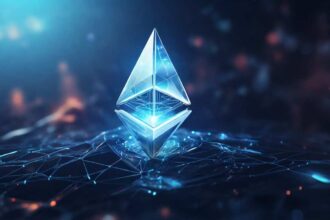Non-Fungible Tokens, or NFTs, have ascended to the limelight since the crypto bull market of 2021. Blockchain-based digital assets went from relative obscurity to a rapidly maturing asset class among investors and collectors. Apart from the hyperbolic rise of NFT marketplaces, record-breaking purchases, and the establishment of widely successful NFT projects, several NFT blockchains have emerged with their own thriving community of ardent users.
Ethereum is considered the go-to NFT blockchain due to its established history and large user base. However, other blockchains like Solana and Polygon have grown to establish themselves as other top NFT hubs for creators and collectors for their low fees and fast transaction speeds.
Top NFT Blockchains
NFTs represent a disruptive innovation built on blockchain technology. NFTs’ distinct characteristics of being unique, immutable, and verifiable are facilitated by blockchain technology. Furthermore, the application of smart contracts sets the terms between a buyer and seller. Therefore with the use of blockchain technology and smart contracts, NFTs are transforming the way creators and investors provide authentic proof of ownership of their assets.
NFTs are digital assets that reflect a range of unique products, such as digital art, music, in-game items, and other pieces of digital content. Tangible assets like real estate can also be tokenized as an NFT. The concept of legitimate proof of ownership is a primary benefit of NFTs. As a result, NFTs reflect a trust-based technology with the potential to permeate across several industries like real estate, music, artwork, and fashion to name a few.
While creators and buyers have the option to leverage this power of legitimate ownership through a myriad of blockchain networks today, each blockchain network has its own unique set of considerations. This includes network size, fees, community, and security. Therefore, before minting or trading NFTs, it is vital to understand the different NFT blockchains that support the underlying infrastructure of the ecosystem.
Ethereum
![What Are the Top NFT Blockchains? [2025] 2 ethereum](http://droomdroom.com/wp-content/uploads/2023/03/ethereum-logo-portrait-black-gray-1-1024x447.jpg)
Ethereum is the most popular NFT blockchain and ecosystem despite mounting competition from other blockchain networks in recent years. It is the leading blockchain for NFTs in terms of users and trading volume due to various reasons. The Ethereum blockchain has a first-mover advantage since it was among the first few blockchains to pioneer the concept of NFTs.
Apart from being a highly decentralized blockchain offering all the functionalities of immutability and transparency required to trade NFTs, several influential projects like CryptoKitties and Crypto Punks native to Ethereum inspired a myriad of profile-picture style (PFP) NFT projects. Moreover, the most popular NFT marketplaces, such as OpenSea, LooksRare, and many more, rose to prominence on the Ethereum blockchain.
Another factor that contributes to Ethereum being the leading NFT blockchain is its large and active developer community, which has created a plethora of platforms and tools for NFT creation, trading, and storage. As a result of the availability and ease of use of several NFT marketplaces and the most popular NFT projects with the largest market caps existing on Ethereum, many high-profile artists and celebrities have chosen the network for their NFT releases and purchases. This has resulted in a positive feedback loop, resulting in a thriving and vibrant NFT ecosystem on Ethereum.
However, the popularity of NFTs on Ethereum has often resulted in network congestion which results in high network transaction fees, also known as gas fees.
A user paid 36.8 ETH in gas fees to mint the first PoS NFT on Ethereum pic.twitter.com/jagrqgFwUc
— Blockworks (@Blockworks_) September 15, 2022That said, the Ethereum blockchain has taken giant strides to alleviate this issue with massive recent upgrades, such as the merge from Proof of Work (PoW) to Proof of Stake (PoS). Although switching to PoS doesn’t directly reduce gas prices, it lays the groundwork for future technical advancements like sharding, which could theoretically reduce congestion and enhance transaction throughput.
Solana
![What Are the Top NFT Blockchains? [2025] 3 Solana](http://droomdroom.com/wp-content/uploads/2023/03/Solana-logo-1024x294.png)
Solana has quickly grown to establish itself as the second-largest NFT blockchain. It was founded in 2020 by engineer and developer Anatoly Yakovenko to solve the high costs and slow transaction speeds common in blockchains like Ethereum and Bitcoin. Solana represents one of the fastest-growing ecosystems in crypto with a market cap of over $7 billion as of this writing.
Solana has become a household name in the NFT sphere due to its fast transaction speeds and the lack of expensive gas fees brought on by its unique hybrid consensus model of Proof of History and Proof of Stake. Solana’s transaction-per-second speeds and low fees have attracted newcomers looking to buy or create their first NFT while sidestepping exorbitant transaction costs.
Want to learn more about solana? here is a detailed webstory that highlights its core fundamentals.
Initial NFT projects on Solana mainly comprised of derivatives of popular Ethereum-based NFTs. For example, Solana’s Sol Punks was inspired by the Crypto Punks collection. However, as Solana’s NFT ecosystem matured, seminal original projects such as DeGods and Okay Bears soon rose to prominence as Solana NFTs.
Although Ethereum reigns supreme in the number of NFT marketplaces, there are many established marketplaces on Solana to choose from. These include Solanart, Solsea, and its largest marketplace Magic Eden to name a few. Furthermore, the adoption of Solana as a legitimate NFT blockchain is evident with Magic Eden adding cross-chain functionality to its formerly Solana-only platform and OpenSea adding support for Solana NFT trades.
Solana, however, remains much less widely known than Ethereum. It is a relatively new blockchain that receives far less mainstream media attention. Due to its smaller user base, Solana has fewer NFT marketplaces and significantly lower trading volumes than Ethereum. NFT collectors and traders depend on liquidity, and in this regard, Ethereum remains on top. It is also worth noting that the Solana network has previously faced scathing criticism for a number of network outages, calling into question its reliability in comparison to other NFT blockchain networks.
Polygon
![What Are the Top NFT Blockchains? [2025] 4 Polygon-logo](http://droomdroom.com/wp-content/uploads/2023/03/Polygon-logo-1024x428.png)
The Polygon network, formerly Matic, was established in 2017 by experienced Ethereum developers Jaynti Kanani, Sandeep Nailwal, and Anurag Arjun. It is a layer-2 scaling solution or sidechain for Ethereum and was created to help reduce transaction costs and speeds significantly.
Polygon has recently emerged as a top contender to other leading NFT blockchains. With over $745 million in NFT trading volume, according to Cryptoslam, Polygon has cemented its place as one of the largest NFT blockchains. Efficiency is at the core of all layer-2 blockchain networks, and Polygon is no different, offering minimal fees and near instantaneous transaction speeds and settlements. While low fees and fast transaction times have drawn NFT enthusiasts, another appealing feature is lazy minting, which requires no upfront costs for creating new NFTs.
The network’s expansion into the NFT space has also been facilitated by Polygon’s increasing number of partnerships with mainstream brands to launch their NFTs. With projects like Starbucks’ Odyssey Program, Nike’s.swoosh platform, Reddit’s digital avatars, and DraftKing’s NFT marketplace all using Polygon, it has rapidly established itself as the preferred blockchain for NFTs of Web2 companies.
Mass adoption happening on @0xPolygon.@BankofAmerica loves the @Starbucks Odyssey program!
“Starbucks can also generate incremental revenue in perpetuity from royalty streams linked to secondary sales, the firm said, citing Nike as an example.”
Yes, @Nike is also on Polygon. pic.twitter.com/olDwwa4cTh
— Ryan Wyatt (fwiz.polygon) (@Fwiz) February 28, 2023Polygon remains a newcomer vying for market share among other NFT blockchains. However, several projects like Polygon Ape YC, Lens Protocol, and NFT-based games like Aavegotchi have gained attention across the broader NFT community. In addition, other recent projects on Polygon have brought notable personalities to the NFT space, such as former US president Donald Trump’s collection of digital trading cards. The confluence of recent partnerships with established web2 companies and influential personalities is the impetus for catapulting Polygon to the limelight while bringing NFT mass adoption.
OpenSea Polygon daily volume on the rise.
2023 is looking bullish for Polygon NFTs. pic.twitter.com/6vSzWDT0oi
— Narb (@NarbTrading) February 6, 2023Despite having fewer marketplace options than Ethereum, NFTs created on Polygon are supported by popular platforms like OpenSea, Magic Eden, and Rarible.
Conclusion
This article has sought to highlight some of the leading blockchains with thriving NFT ecosystems. However, it is vital to note that rankings in this realm are subject to constant change due to the fast-paced and continuously evolving nature of the nascent NFT sector and broader cryptocurrency space. There are several other blockchains, namely Binance Chain, Flow, and ImmutableX, that are making strides in the NFT sector.
![What Are the Top NFT Blockchains? [2025] 5 Top-blockchains](http://droomdroom.com/wp-content/uploads/2023/03/Top-blockchains-by-NFT-trading-volume.jpg)
Furthermore, the recent rise of the ordinals protocol, which brings NFTs to Bitcoin, typifies how frequently the NFT landscape changes.
For a comprehensive explanation of Bitcoin ordinals, read this article.
NFTs have surfaced as an asset class within the cryptocurrency ecosystem. The proliferation of this sector has been met with the surge of several blockchains that support the innovation. While Ethereum currently holds the top spot, other promising blockchains offer their fair share of positives when it comes to creating or trading NFTs. It is, therefore, vital that creators and collectors alike weigh out the pros and cons of each NFT blockchain before embarking on the NFT revolution.

![What Are the Top NFT Blockchains? [2025] 1 NFT blockchain](http://droomdroom.com/wp-content/uploads/2023/03/NFT-1-615x410.jpeg)














